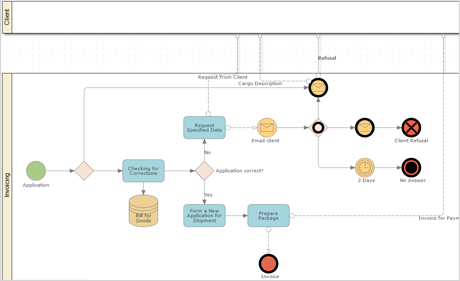A diagram library that enables you to build any type of graph, flowchart, tree, org chart, diagram, process chart, database schema and much more. Includes a huge variety of prdefined node and link shapes, automatic layout algorithms, many import and export options.
For the latest stable version:
npm install @mindfusion/diagramming
Set the enableSpatialIndex property of Diagram to create an index of item positions for faster hit-testing and viewport clipping queries. This should greatly improve user interaction and rendering speed for diagrams containing tens of thousands or more items.
diagram.nodeCreated.addEventListener(
(sender, args) =>
{
if (sender.defaultShape.id == "Rectangle")
args.node.anchorPattern = pattern1;
else
args.node.anchorPattern = pattern2;
});
- The foldedSize property of ContainerNode specifies the container's size when it is folded.
- clipText property added to ShapeNode.
- actionUndone and actionRedone events raised by undo manager for eithertop-level commands or children of CompositeCommand.
- Fixed multiple resize when selection contains rotated nodes.
- Fixed rotation when rotation handle is at a custom position (set from hitTestAdjustmentHandle event handler).
- strokeThickness is now scaled by zoomFactor.
The constraints property lets you apply size and direction constraints to a node. It returns a NodeConstraints object with following properties:
- keepRatio: a bool value indicating whether the initial width/height ratio of a node should be preserved.
- maxHeight: the maximum node height allowed.
- maxWidth: the maximum node width allowed.
- minHeight: the minimum node height allowed.
- minWidth: the minimum node width allowed.
- moveDirection: a member of the DirectionConstraint enumeration. Set it to Horizontal or Vertical to let users move a node only in specified direction.These constraints are considered when a user modifies the node interactively. They are ignored if node placement is changed programmatically by using API methods and properties.
- TabbedDiagramView now keeps separate zoom level and scroll position per tab.
- shapeLibraryLoaded event raised when library XML file is loaded and its shape definitions are available for use.
- fixed undo / redo of text in-place edit operations.
- fix for item hover events of DiagramDocument not raised by TabbedDiagramView.
- The anchorPattern property of Shape lets you associate anchor points with shape definitions. That pattern is shared between all nodes of same shape, but can be overridden by setting node's own anchorPattern.
- Individual segments of a shape's geometry can be styled independently bysetting stroke and fill attributes of ShapeElement and ShapeDecoration objects.
- We have replaced the Windows -only shape designer tool with an online shape editor at https://mindfusion.eu/tools/shape-designer.html
- The shape editor is implemented as a reusable ShapeDesigner control, which can be integrated into your own applications.
Event emitter objects are now exposed as properties of Diagram and DiagramView and you can register handlers by calling their addEventListener method:
diagram.nodeCreated.addEventListener(
(sender, args) =>
{
if (sender.defaultShape.id == "Rectangle")
args.node.anchorPattern = pattern1;
else
args.node.anchorPattern = pattern2;
});
Legacy event handling syntax will remain supported for compatibility with old code.
Table rows can be assigned to distinct sections of the table. Each section can be collapsed or expanded, hiding or showing all rows in the section except the header one. To define a section, set the header property of a row. A section consists of all rows after a header row and spans to the next header. Each header row displays [±]a button that allows expanding or collapsing the section interactively. Clicking that button raises the tableSectionCollapsed and tableSectionExpanded events. Sections can be collapsed or expanded programmatically by setting the expanded property of their header rows.
- dividerStroke properties added to ContainerNode, TableNode and TreeViewNode classes. It lets you customize the appearance of the divider line drawn between a node's caption bar and content area.
- removed an eval call used for creating custom components from CompositeNode Json templates, allowing for stricter Content Security Policy rules. Now custom components must be registered by calling registerComponent method to allow instantiating them from a template.
- linkRouted event raised when links are modified by automatic routing.
To allow for stricter Content Security Policy rules, the library no longer loads CSS scripts automatically. If you use components from the Diagramming.Controls package, you must now explicitly link the common-ui.css file from the distribution's themes folder.
The DiagramView React component allows integrating the MindFusion.Diagramming API into React applications. It renders a Diagram instance assigned to "diagram" prop as its model. Most diagram properties can be set from JSX, and all diagram events can be handled through JSX syntax as well. For more information, see the Integration with React topic.
The DiagramView component for Rect on npm.
The diagram-view Vue.js component allows integrating the MindFusion.Diagramming API into Vue.js applications. It renders a Diagram instance assigned to "diagram" prop as its model. Most diagram properties can be set from the vue template, and all diagram events can be handled through the v-on directive as well. For more information, see the Integration with Vue.js topic.
The DiagramView component for Vue on npm.
The diagram-view Angular component allows integrating the MindFusion.Diagramming API into Angular applications. It renders a Diagram instance assigned to "diagram" property as its model. Most diagram properties can be set from the html template, and all diagram events can be handled through event binding syntax as well. For more information, see the Integration with Angular topic.
The DiagramView component for Angular on npm.
The diagram library is also included in MindFusion Pack for JavaScript.
(https://mindfusion.eu/tools/shape-designer.html)[https://mindfusion.eu/tools/shape-designer.html]
A variety of online samples are uploaded at the MindFusion Js Diagram website. You can also visit the online demo for Js Diagram. You can download an archive with all samples and all files for the library from here.
Learn more about JS Diagram from the official product page. Stay in touch with MindFusion about our latest product announcements, tutorials and programming guidelines via Twitter or our company blog.
The end-user license agreement for JS Diagram is here.

